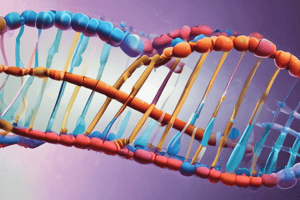Podcast
Questions and Answers
What is the function of helicase?
What is the function of helicase?
- Opens the DNA for replication (correct)
- Reads the DNA template strand
- Joins Okazaki fragments
- Synthesizes the new DNA strand
What does DNA Polymerase III do?
What does DNA Polymerase III do?
Reads the DNA template strand 3'-5' and synthesizes the new strand 5'-3'
What characterizes the leading strand in DNA replication?
What characterizes the leading strand in DNA replication?
Strand of freshly copied DNA which is continuously made
What is the lagging strand?
What is the lagging strand?
What does topoisomerase do?
What does topoisomerase do?
What role does Single-Stranded Binding Protein play in DNA replication?
What role does Single-Stranded Binding Protein play in DNA replication?
What is the function of RNA primase?
What is the function of RNA primase?
What is an Okazaki fragment?
What is an Okazaki fragment?
What does DNA Polymerase I do?
What does DNA Polymerase I do?
What is ligase and its role in DNA replication?
What is ligase and its role in DNA replication?
What is a parent strand in DNA replication?
What is a parent strand in DNA replication?
What is an RNA primer?
What is an RNA primer?
Flashcards are hidden until you start studying
Study Notes
DNA Replication Fork Components
- Helicase: Enzyme responsible for unwinding the double helix structure of DNA, enabling replication.
- DNA Polymerase 3: Enzyme that reads the template strand in the 3' to 5' direction and synthesizes the new DNA strand in the 5' to 3' direction.
DNA Strands
- Leading Strand: Continuously synthesized strand of DNA that is formed in the same direction as the replication fork opens.
- Lagging Strand: Synthesized in short segments (Okazaki fragments) in the opposite direction of the replication fork, from 3' to 5'.
Enzymatic Functions
- Topoisomerase: Relieves molecular tension ahead of the replication fork, facilitating easier strand separation.
- Single-Stranded Binding Protein: Binds to single-stranded regions of DNA to prevent strands from re-annealing, allowing for successful replication.
- RNA Primase: Synthesizes a short RNA primer on the lagging strand to initiate DNA synthesis.
Fragmentation in Lagging Strand
- Okazaki Fragment: Short sequences of DNA synthesized on the lagging strand between RNA primers, eventually joined to form a continuous strand.
RNA and DNA Replacement
- DNA Polymerase 1: Enzyme that replaces RNA primers with DNA after synthesis, ensuring that the final product is entirely DNA.
- Ligase: Enzyme that seals the gaps between Okazaki fragments, joining them into a continuous DNA strand.
Key Terminology
- Parent Strand: Original DNA strands that serve as templates for replication.
- RNA Primer: Short sequence of RNA nucleotides that provides a starting point for DNA synthesis.
Studying That Suits You
Use AI to generate personalized quizzes and flashcards to suit your learning preferences.




